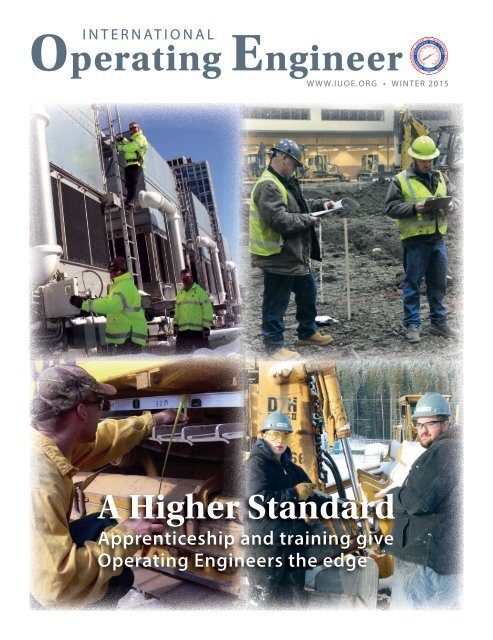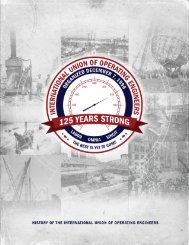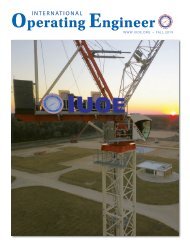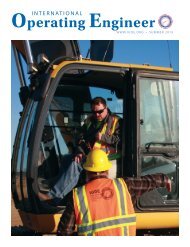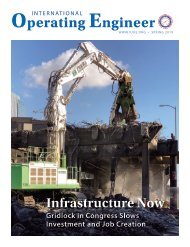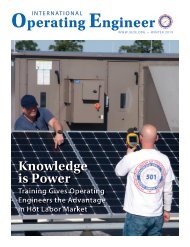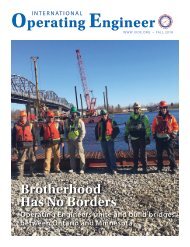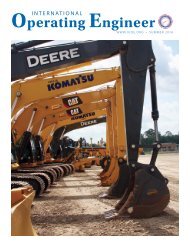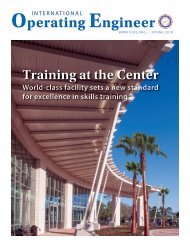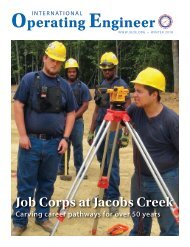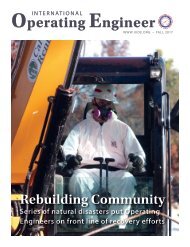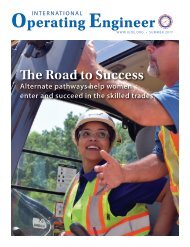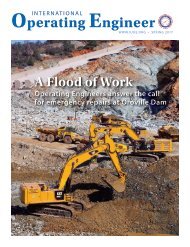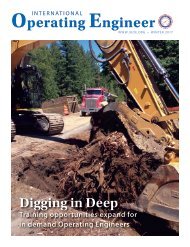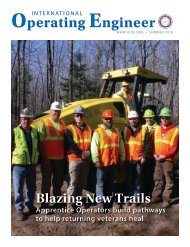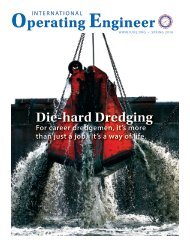Operating Engineer - Winter 2015
The quarterly magazine of the International Union of Operating Engineers.
The quarterly magazine of the International Union of Operating Engineers.
You also want an ePaper? Increase the reach of your titles
YUMPU automatically turns print PDFs into web optimized ePapers that Google loves.
i n t e r n at i o n a l<br />
<strong>Operating</strong> <strong>Engineer</strong><br />
WWW.IUOE.ORG • WINTER <strong>2015</strong><br />
A Higher Standard<br />
Apprenticeship and training give<br />
<strong>Operating</strong> <strong>Engineer</strong>s the edge
2<br />
INTERNATIONAL OPERATING ENGINEER
i n t e r n at i o n a l<br />
<strong>Operating</strong> <strong>Engineer</strong><br />
<strong>Winter</strong> <strong>2015</strong> • Volume 158, No. 1<br />
Brian E. Hickey, Editor<br />
Jay C. Lederer, Managing Editor<br />
17 Transportation Infrastructure<br />
Big decisions on long-term funding loom<br />
18 Right-to-Work (for less)<br />
Labor battles erupt again in state capitals<br />
14 Job Corps: The Next Generation<br />
Local programs sow the seeds for success<br />
Departments<br />
05 From the General President<br />
06 Politics & Legislation<br />
10 Education & Training<br />
16 Safety & Health<br />
18 HAZMAT<br />
20 Canadian News<br />
22 Member Spotlight<br />
24 GEB Minutes<br />
28 In Memorium<br />
[left] IUOE Local 49’ers continue to work on the new Vikings<br />
Stadium despite the harsh Minneapolis winter.<br />
[photo] Leila Navidi/ www.startribune.com<br />
WINTER <strong>2015</strong> 3
International <strong>Operating</strong> <strong>Engineer</strong><br />
(ISSN 0020-8159) is published by the:<br />
International Union of<br />
<strong>Operating</strong> <strong>Engineer</strong>s, AFL-CIO<br />
1125 17 th Street, NW<br />
Washington, DC 20036<br />
Subscription Terms - $5 per year<br />
Change of Address - Requests must<br />
be submitted in writing to the IUOE<br />
Membership Department (address<br />
above). Include your new address,<br />
registration and local union number.<br />
POSTMASTERS – ATTENTION:<br />
Change of address on Form 3579<br />
should be sent to:<br />
International <strong>Operating</strong> <strong>Engineer</strong><br />
Mailing List Dept.<br />
1125 17th St., NW, 3rd Floor<br />
Washington, DC 20036<br />
Publications Mail Agreement No.<br />
40843045<br />
Return undeliverable Canadian<br />
addresses to:<br />
2835 Kew Drive<br />
Windsor, ON N8T3B7<br />
Printed in the U.S.A.<br />
International Union of <strong>Operating</strong> <strong>Engineer</strong>s<br />
AFL-CIO<br />
general officers<br />
James T. Callahan, General President<br />
Brian E. Hickey, General Secretary-Treasurer<br />
William C. Waggoner, First Vice President<br />
Patrick L. Sink, Second Vice President<br />
Jerry Kalmar, Third Vice President<br />
Russell E. Burns, Fourth Vice President<br />
James M. Sweeney, Fifth Vice President<br />
Robert T. Heenan, Sixth Vice President<br />
Daniel J. McGraw, Seventh Vice President<br />
Daren Konopaski, Eighth Vice President<br />
Michael Gallagher, Ninth Vice President<br />
Greg Lalevee, Tenth Vice President<br />
Terrance E. McGowan, Eleventh Vice President<br />
Louis G. Rasetta, Twelfth Vice President<br />
Mark Maierle, Thirteenth Vice President<br />
Randy Griffin, Fourteenth Vice President<br />
trustees<br />
Kuba J. Brown, Chairman<br />
Bruce Moffatt, Trustee<br />
James T. Kunz, Jr., Trustee<br />
Joseph F. Shanahan, Trustee<br />
Edward J. Curly, Trustee<br />
Got Big<br />
News<br />
?<br />
from Your<br />
Local<br />
We want to<br />
hear about it.<br />
International <strong>Operating</strong> <strong>Engineer</strong><br />
appreciates the stories and<br />
photos we receive from<br />
local affiliates throughout<br />
North America. Send us your<br />
submissions or ideas for stories<br />
you would like us to consider.<br />
Send your submissions, plus<br />
photos (digital images are<br />
preferred), to Jay Lederer<br />
at jlederer@iuoe.org, or mail<br />
1125 Seventeenth Street, N.W.,<br />
Washington, D.C., 20036<br />
4<br />
INTERNATIONAL OPERATING ENGINEER
From the General President<br />
[James T. Callahan]<br />
Building a Better Future Today<br />
CARRYING FORWARD POSITIVE<br />
momentum into the New Year, Locals<br />
from across the International have<br />
reported an increase in man-hours<br />
throughout all of our traditional H&P<br />
work. By all indications, this trend<br />
looks likely to continue.<br />
But the feast or famine nature of<br />
construction presents many challenges<br />
to manning projects. We experienced<br />
this last year with a shortage of crane<br />
operators in parts of the United States<br />
and Canada. Now is the time to recruit<br />
those who remain unorganized, while<br />
the work is plentiful. Our commitment<br />
to organizing, in both H&P and<br />
Stationary, is steadfast and we will<br />
continue to deploy the resources<br />
needed to compete in this expanding<br />
market.<br />
We must also remain vigilant to<br />
maintain our core jurisdictions. As<br />
we have seen with every construction<br />
boom, our attention often gets turned<br />
to the large and mega projects, along<br />
with our contractors, leaving a void to<br />
be filled by the non-union shops. In<br />
this void, we also see union-friendly<br />
contractors move in from other types<br />
of construction, who choose to assign<br />
our core work to other crafts that they<br />
are more familiar with. This leaves us<br />
fighting on two fronts.<br />
Let’s learn from these past<br />
oversights and keep our eye on the<br />
smallest of projects, where even<br />
just one <strong>Operating</strong> <strong>Engineer</strong> may be<br />
needed, as it will serve to protect our<br />
core work.<br />
For over a year, the International’s<br />
Stationary Affairs Department has been<br />
working with the Department of Energy<br />
and the National Institute of Building<br />
Sciences through the Commercial<br />
Workforce Credentialing Council.<br />
They have developed voluntary<br />
national guidelines concerning four<br />
energy related jobs, including Building<br />
<strong>Operating</strong> Professional, which is work<br />
normally performed by Stationary<br />
<strong>Engineer</strong>s.<br />
This year, we will pursue recognition<br />
of our Energy Conservation Course<br />
through the Interstate Renewable<br />
Energy Council. This will give our<br />
Certificate of Completion even greater<br />
industry recognition.<br />
The high standards that we helped set<br />
for the Building <strong>Operating</strong> Professional<br />
Certification are so comprehensive that<br />
the non-union employers are upset<br />
with the rigor and training required<br />
to obtain it. They are trying to water it<br />
down, but we are resisting. We believe<br />
that most Stationary <strong>Engineer</strong>s that<br />
have completed our apprenticeship<br />
program, followed by the Energy<br />
Conservation course, will be well<br />
suited to fill these certified rolls.<br />
As we press forward, we must also<br />
contend with political forces that are<br />
openly hostile towards organized<br />
labor and working families. As a result<br />
of the mid-term elections, political<br />
power shifted in Congress and we are<br />
faced with new Senate leadership that,<br />
along with an extremely conservative<br />
majority in the House, is less inclined<br />
to agree with us on our core issues.<br />
We anticipate attempts in both the<br />
House and Senate to repeal or weaken<br />
the Davis-Bacon and Service Contract<br />
Acts and possibly to pass a national<br />
Right-to-Work law. Anti-worker<br />
extremists are also trying to weaken<br />
the National Labor Relations Board,<br />
which has recently passed a series of<br />
rules that would help level the playing<br />
field for workers who seek union<br />
representation.<br />
All of this will play out as the<br />
International, along with other allies<br />
in labor, business and equipment<br />
manufacturing, press Congress for a<br />
long-term transportation bill. In July,<br />
Congress patched an $11 billion dollar<br />
hole in the Highway Trust Fund to<br />
extend the law through this May.<br />
But short-term patches, using<br />
budgetary gimmicks, will not<br />
address the growing problem of our<br />
substandard transportation system.<br />
The Highway Trust Fund is the largest<br />
federal infrastructure program and a<br />
key job creating engine for <strong>Operating</strong><br />
<strong>Engineer</strong>s. Passing a comprehensive<br />
bill is a top priority for the International.<br />
Most urgent are the anti-worker<br />
bills being proposed in various states.<br />
Legislatures in Michigan, Missouri,<br />
Nevada, New Mexico, West Virginia<br />
and Wisconsin are considering bills<br />
to establish Right-to-Work, impose<br />
paycheck deception and attack<br />
prevailing wage. In Illinois, newly<br />
elected governor has bypassed the<br />
legislature to attack unions directly,<br />
issuing an executive order which<br />
equates to a form of Right-to-Work.<br />
On all these fronts, the International<br />
is working with our Locals to stand up<br />
and fight back, using all political and<br />
legal tools available. But many people<br />
don’t understand the full impact of<br />
these laws and what they would do to<br />
working families.<br />
That’s where you, the members of<br />
this great organization, have a powerful<br />
role. All of us must commit ourselves<br />
to spreading the word—to family,<br />
friends, neighbors and our elected<br />
representatives—of what it means to<br />
be in a labor union and what’s at stake.<br />
I am confident that by standing<br />
together and raising our collective<br />
voice in support of our union brothers<br />
and sisters—no matter where we live<br />
or what job we do each day—we will<br />
prevail and continue our progress<br />
towards a better future.<br />
Stand up. Be heard. Work safe.<br />
WINTER <strong>2015</strong> 5
Politics & Legislation<br />
Can the New Congress Get Anything Done?<br />
THE 114TH CONGRESS is<br />
underway with Republican majorities<br />
in both the House and the Senate.<br />
Right out of the gate, Congressional<br />
leaders made passage of the Keystone<br />
XL pipeline their top legislative<br />
priority. The House acted first and the<br />
Senate followed, both with bipartisan<br />
support, passing legislation that took<br />
the decision away from the President<br />
and deemed the pipeline ready for<br />
construction.<br />
As of this writing, President Obama<br />
plans to veto the bill when it reaches his<br />
desk and continue the current process<br />
of review by the State Department over<br />
the merits of the project, a process<br />
that has been going on for six years<br />
now. Although the pipeline project<br />
did garner widespread support in<br />
Congress, there are not enough votes<br />
to overcome the anticipated veto.<br />
There are a number of new faces<br />
in Congress, with many members<br />
supportive of <strong>Operating</strong> <strong>Engineer</strong>s,<br />
from both sides of the aisle, not<br />
returning to Washington. The IUOE<br />
Legislative and Political Department<br />
has been meeting with new members<br />
and identifying those who are willing<br />
to work with us on core issues like the<br />
preservation of the Davis-Bacon and<br />
Service Contract Acts, investing in our<br />
national infrastructure, and protecting<br />
and strengthening the overall rights of<br />
workers.<br />
Legislation of importance to<br />
<strong>Operating</strong> <strong>Engineer</strong>s in the 114th<br />
Congress is the authorization of a<br />
new, long-term highway bill and the<br />
updating of the laws that govern energy<br />
production for projects such as natural<br />
gas pipelines, liquefied natural gas<br />
export facilities and power plants.<br />
We also anticipate fights on the<br />
floors of the House and Senate over<br />
anti-union legislation, such as bills<br />
to repeal or weaken the Davis-Bacon<br />
and Service Contract Acts and even an<br />
attempt to pass a national right-to-work<br />
law. Rabid union foes like Rep. Steve<br />
King (R-IA), Sen. Mitch McConnell<br />
(R-KY), and others, have signaled that<br />
these fights are sure to come over the<br />
next two years.<br />
The International will be doing<br />
everything it can to move our pro-jobs,<br />
pro-worker agenda, while fighting off<br />
any anti-union legislation. Members<br />
can keep up to date on all of these<br />
legislative issues by routinely checking<br />
the IUOE web site and get active by<br />
signing up for the <strong>Engineer</strong>s Action<br />
and Response Network (EARN), also<br />
through the web site.<br />
6<br />
INTERNATIONAL OPERATING ENGINEER
Road Ahead for Long-Term Transportation Bill Still Unclear<br />
OUR NATION’S ROADS stretch<br />
more than 4 million miles and support<br />
3 trillion vehicle miles each year.<br />
But in 2013, the American Society<br />
of Civil <strong>Engineer</strong>s graded our roads<br />
a D on its Report Card for America’s<br />
Infrastructure, in part because<br />
congestion alone cost the economy<br />
an estimated $101 billion annually in<br />
wasted time and fuel. Our bridges, too,<br />
merited only a C+.<br />
It shouldn’t take horrific<br />
events like the 2007 collapse of the<br />
I-35W Mississippi River bridge in<br />
Minneapolis – which killed 13 people<br />
– and the 2013 I-5 Skagit River Bridge<br />
collapse north of Seattle to remind us<br />
that our transportation infrastructure<br />
is under-funded and falling apart.<br />
More than 25 percent of our bridges<br />
are either structurally deficient or<br />
functionally obsolete, and that’s simply<br />
unacceptable.<br />
Because the gas tax hasn’t been<br />
raised in more than twenty years, the<br />
Highway Trust Fund is at constant risk<br />
of insolvency. Last August, Congress<br />
narrowly averted bankrupting the<br />
Fund by passing the Highway and<br />
Transportation Funding Act of 2014,<br />
which provided funding through May<br />
31st of this year. But that means that in<br />
just a few short months, if Congress fails<br />
to pass a new surface reauthorization,<br />
the Department of Transportation will<br />
be forced to ration highway and transit<br />
funds for states.<br />
It’s not enough for Congress to<br />
simply pass another short-term<br />
extension at that point, either. Truly<br />
effective infrastructure construction<br />
and repair takes place over the long<br />
term: you can’t build a new highway or<br />
bridge in just a month or two. Without<br />
certainty about long-term federal<br />
investment, many states have already<br />
begun to pull back from transportation<br />
projects – exactly the opposite of what<br />
our surface transportation network<br />
and economy need now.<br />
And without a long-term funding<br />
plan, transportation jobs will<br />
continue to languish. While many<br />
parts of the economy have improved<br />
significantly from the Great Recession,<br />
unemployment in the construction<br />
sector still stands at 9.8 percent.<br />
While most of the economic effects of<br />
transportation investment accrue over<br />
the long-term, 68 percent of jobs related<br />
to infrastructure investment are in the<br />
construction sector – so investing in<br />
surface transportation means investing<br />
in good jobs for <strong>Operating</strong> <strong>Engineer</strong>s<br />
and other construction crafts.<br />
There is hope: many in Congress<br />
have stopped ignoring the urgency<br />
of this problem and have begun to<br />
propose solutions to this funding crisis.<br />
Some have called for an increase<br />
in the federal gas tax and indexing it<br />
to inflation for future investments to<br />
the Highway Trust Fund. Others are<br />
looking to tax barrels produced at the<br />
refinery level, instead of at the pump,<br />
in order to prop up the fund. And<br />
others, including President Obama, are<br />
looking to generate billions through<br />
international corporate tax reform and<br />
dedicating that revenue to the fund<br />
over the next six years.<br />
Several other proposals have also<br />
been floated, but it’s unclear which<br />
of these might gain momentum and<br />
consensus before the Highway Trust<br />
Fund becomes insolvent, yet again, at<br />
the end of May.<br />
The IUOE has allied with other<br />
labor and business groups to pressure<br />
Congress into passing a long-term bill<br />
that will make serious investments in<br />
our roads, bridges, and transit systems<br />
and that will bring good paying jobs to<br />
<strong>Operating</strong> <strong>Engineer</strong>s for years to come.<br />
WINTER <strong>2015</strong> 7
Right-to-Work (for less)<br />
Labor Battles Erupt Again in State Capitals<br />
Fights underway over Right-to-Work and prevailaing wage laws<br />
EMBOLDENED BY PASSAGE of socalled<br />
Right-to-Work laws in Michigan<br />
and Indiana, the throttling of collective<br />
bargaining rights in Wisconsin, and<br />
the cutting of pension benefits in New<br />
Jersey over the past few years, state<br />
lawmakers once again are targeting<br />
unionized workers in multiple states.<br />
Newly elected Illinois Gov. Bruce<br />
Rauner issued an executive order on<br />
February 9, allowing public sector<br />
workers to refuse payment of “fair<br />
share” union dues or their equivalent.<br />
Rauner has also called for the creation<br />
of local “right-to-work zones” and for a<br />
prohibition against political donations<br />
from unions with state contracts.<br />
At the same time, Rauner is<br />
attempting to head off an expected<br />
legal challenge from organized labor<br />
by filing his own lawsuit against more<br />
than a dozen unions, including the<br />
IUOE, claiming that fair share dues are<br />
unconstitutional.<br />
Meanwhile, Right-to-Work bills<br />
have gained traction in Missouri, New<br />
Mexico and West Virginia that would<br />
prohibit public and/or private sector<br />
unions from collecting mandatory<br />
dues or their equivalent in workplaces<br />
that they’ve organized. The bills have<br />
already cleared committee hurdles in<br />
Missouri and New Mexico.<br />
In Wisconsin, where Gov. Scott<br />
Walker had dodged the question for<br />
months, the right-wing Republican<br />
controlled legislature is now rushing to<br />
pass Right-to-Work after the governor<br />
vowed he would sign it into law there.<br />
And in Kentucky, right-to-work<br />
ordinances have been passed in five<br />
counties this year, though their legality<br />
is being challenged in court.<br />
Further attacks aimed directly at<br />
building trades unions have cropped<br />
up with bills designed to repeal state<br />
prevailing wage laws in Indiana,<br />
EnginEErs Action rEsponsE nEtwork<br />
Because elections matter<br />
Make your voice heard • Register for EARN today<br />
www.iuoe.org<br />
Michigan, Missouri, Nevada and West<br />
Virginia.<br />
This renewed targeting of the<br />
unionized workforce is primarily<br />
the result of November’s Republican<br />
sweep, in which the GOP seized the<br />
governorships of Massachusetts,<br />
Maryland, Arkansas and Illinois, all<br />
previously Democratic, while losing<br />
only Pennsylvania.<br />
The Republicans also acquired<br />
control of 11 previously-Democratic<br />
legislative chambers, including the<br />
West Virginia House, the New York<br />
Senate and the Nevada Assembly and<br />
Senate. According to the National<br />
Conference of State Legislatures,<br />
Republicans haven’t controlled this<br />
many state legislative seats since 1920.<br />
The International is working closely<br />
with Local affiliates to track and push<br />
back on these and other emerging<br />
threats. Mobilization campaigns<br />
are underway in<br />
several states and<br />
members are urged<br />
to contact their<br />
state legislators<br />
directly to voice<br />
their opposition<br />
to these attacks<br />
on collective<br />
bargaining rights<br />
and prevailing<br />
wages. Members in<br />
these battleground<br />
states are receiving<br />
information on<br />
how they can help<br />
and should also<br />
check in with their<br />
local Business<br />
Managers to find<br />
out more.<br />
8<br />
INTERNATIONAL OPERATING ENGINEER
IUOE<br />
National Training Fund<br />
Become an American Red Cross Authorized Provider<br />
Card Fees - Discounted over 20% (2-year certification):<br />
New Certification: Full Price - $27.00 IUOE Price - $20.00<br />
Recertification: Full Price - $19.00 IUOE Price - $15.00<br />
Access all American Red Cross training materials for FREE!<br />
• Instructor Manuals<br />
• Student Manuals and Reference Cards<br />
• Videos and Interactive Teaching Presentations<br />
Online access to report activity online and print certificates on demand.<br />
Bridging for American Heart Association Instructors to ARC - FREE!<br />
Receive quarterly training for FREE!<br />
Materials available for training through the National HAZMAT Program:<br />
• CPR Manikins<br />
• AED Trainers<br />
• First Aid Kits<br />
• Instructor and Student Manuals<br />
(if needed)<br />
Please contact Amanda Petry at (888)<br />
877-6974 or apetry@iuoehazmat.org to<br />
join the IUOE NTF’s National Account.<br />
WINTER <strong>2015</strong> 9
Education & Training<br />
Stationary <strong>Engineer</strong>s Keep Things Chill All <strong>Winter</strong> Long<br />
variable frequency<br />
drives (VFD’s), which<br />
is an integral part of the<br />
cooling tower’s winter<br />
operation. VFD’s are<br />
commonly used to<br />
control the water flow<br />
to the cooling tower<br />
and a separate VFD is<br />
employed to control<br />
the speed at which<br />
air flows through the<br />
cooling tower.<br />
TYPICALLY, WE THINK of our<br />
chilled water plants as part of an<br />
operation that only occurs during<br />
warmer weather when ‘comfort’<br />
cooling is required. However, times<br />
have changed with the addition<br />
of computer server rooms and<br />
other critical systems that require<br />
mechanical cooling around the clock,<br />
every day of the year. In regions where<br />
outside climates can reach well below<br />
32 °F, this can prove quite challenging<br />
when operating a condenser water<br />
plant and its cooling towers.<br />
In the Chicagoland area, Local 399<br />
Stationary <strong>Engineer</strong>s utilize the IUOE’s<br />
on-line Blackboard training modules<br />
for Cooling Towers, as well as other<br />
resources, to ensure their operators<br />
have a full understanding of how these<br />
systems are to operate under adverse<br />
conditions.<br />
During the cold winter months,<br />
Stationary <strong>Engineer</strong>s must understand<br />
the effects of the air flowing though the<br />
tower and water flow rates, as well as the<br />
importance of knowing how the wetbulb<br />
temperatures effect the cooling<br />
towers operation. Continuously<br />
monitoring and controlling the flows of<br />
both the air and water to these cooling<br />
towers and correctly interpreting the<br />
data is critical for both the operation of<br />
the condenser water loop, as well as the<br />
structural integrity of the cooling tower<br />
itself. Using this knowledge keeps the<br />
cooling towers water flowing at desired<br />
temperatures and operating within<br />
safe and acceptable ice formation<br />
limits, which eliminates the possibility<br />
of a catastrophic structural failure.<br />
The cooling tower design and<br />
operation features various primary<br />
and ancillary components which<br />
require maintenance from a highly<br />
trained and skilled engineer. One of<br />
the components often used are the<br />
Jim Rafferty,<br />
an IUOE Local 399<br />
instructor, guides<br />
trainees through some<br />
of the ‘mysteries’ of<br />
basic programming<br />
and operation of the<br />
VFD’s. Some of the<br />
ancillary components,<br />
such as solenoid valves<br />
and electric heat trace,<br />
require additional<br />
training and are offered<br />
as part of the Local’s<br />
training curriculum.<br />
The example above is just one of<br />
the numerous challenges and the skills<br />
sets needed to operate these complex<br />
systems correctly, many of which<br />
require specialized training. But these<br />
are the challenges and opportunities<br />
that when conquered, help us to excel<br />
in our profession. As technology<br />
and processes change, our collective<br />
responsibility is to communicate those<br />
changes to the Local Unions so they<br />
have an opportunity to develop ways to<br />
educate, support and strengthen all of<br />
the members.<br />
[above] Atop of Chicago, Local 399<br />
members Ed Juracka, Mike Lynch and<br />
Brian Yanahan keep the cooling towers<br />
running at maximum efficiency, no matter<br />
what the weather conditions.<br />
[article & photo] Tom Phillips/Local 399<br />
10<br />
INTERNATIONAL OPERATING ENGINEER
Local Instructors Complete Training Standards Project<br />
THE NATIONAL TRAINING FUND<br />
conducted a Training Standards<br />
Project (TSP) Train-the-Trainer course<br />
December 16 to 18, 2014. Twenty local<br />
trainers participated at the event which<br />
was hosted by Local 150 ASIP, using<br />
their indoor training arena.<br />
The TSP is a valuable practical<br />
evaluation tool for <strong>Operating</strong> <strong>Engineer</strong><br />
training programs. The TSP is a time<br />
tested instructor tool that has become<br />
an industry standard over the years.<br />
This class is held to give the instructor a<br />
better understanding of this evaluation<br />
process, which can then be used for<br />
each local’s specific needs.<br />
IUOE local instructors that<br />
participated in this Train-the-Trainer<br />
course were: William Neely (Local 3),<br />
Jim Baldridge (Local 3), Jenny Crist<br />
(Local 3), Mark Shepler (Local 66),<br />
James Grider (Local 181), Allen Moore<br />
(Local 181), James Romanco (Local<br />
234), James Edvenson (Local 234),<br />
Noah Ridgeway (Local 318), Jason<br />
NTF Basic<br />
Teaching<br />
Techniques Class<br />
Finishes Strong<br />
Sissom (Local 318), Jason Stephens<br />
(Local 450), Glen Roberts (Local 450),<br />
Rusty Redman (Local 520), Dean<br />
Andrews (Local 520), George Kirton<br />
(Local 955), Shanon Brickey (Local<br />
965), Jeff Cramer (Local 150), Glenn<br />
Minyard (Local 150), Troy Butler (Local<br />
150), Chris Tomblin Local 150).<br />
THE NATIONAL TRAINING<br />
FUND hosted its final Basic Teaching<br />
Techniques Train-the-Trainer course<br />
of 2014 at the Maritime Institute in<br />
Linthicum Heights, Maryland last<br />
September. There were 24 instructors<br />
representing 14 different IUOE Training<br />
Programs. This course has proven to<br />
be instrumental for both new as well<br />
as seasoned instructors. Attending<br />
this course also helps keep our training<br />
programs in accordance with the<br />
new Federal 29-29 Apprenticeship<br />
standard.<br />
[above] L to R front row: Sean Poyner LU150, Kelly Roblee LU 17, Jason Stephens LU450,<br />
Skip Turner Instructor, John Mason IUOE, Ken Kroeger Instructor, Chris Treml IUOE, Mark<br />
Brandt LU99 - Second row L to R: Rich Rose LU 12, Bill Esser Job Corps, Dean Black LU 150,<br />
Josh Williams LU 17, Claire Smith LU 158, Tony D’Arca LU 324, Derek Sather LU 324, Jason<br />
Debler LU 450, David Sansone LU 406, Matt Ulm LU 649, Bubba Tillis LU 925, Back Row L to<br />
R: Shayne Cooper LU 132, Gary Bowers LU 99, Greg Tucker LU 158, Mark Otto LU 150, Bruce<br />
Prosser LU 150, Tom Sundly LU 49, Frank Bongiovanni LU 150, Matt Bainbridge LU 101,<br />
Todd Peterson LU 150.<br />
WINTER <strong>2015</strong> 11
Education & Training<br />
A Hot Spot to Train: Wisconsin DNR Techs Run the Course<br />
THESE ARE THE PEOPLE who get<br />
thrown into the fire, literally.<br />
Sometimes they’re called to<br />
work in the middle of the night<br />
and find themselves dispatched to<br />
forests, swamps, hillsides, fields, or<br />
residential neighborhoods they’ve<br />
never seen before, not even in daylight.<br />
Surrounded by smoke and engulfed<br />
in darkness, the only way to know for<br />
certain where they are is to keep an<br />
eye on the digital topographic map<br />
displayed on the Global Positioning<br />
System in their bulldozer’s cab.<br />
These Wisconsin Department of<br />
Natural Resources forestry technicians<br />
try to stay in touch with each other by<br />
radios in their dozers as they push and<br />
plow dirt and vegetation to create fire<br />
breaks. But in the heat of the moment,<br />
too many excited voices speaking at<br />
once can overwhelm transmission<br />
frequencies. Radio batteries can<br />
fail. Or a host of other issues can be<br />
counted on to show up to the party at<br />
the worst possible moment and hinder<br />
communications.<br />
At any moment during the fire<br />
fight, these public servants can find<br />
themselves alone, abruptly. Whether<br />
they choose to stay in the fight or<br />
look for a safe route away from the<br />
flames, the techs must be trained<br />
and confident in their skills as heavy<br />
equipment operators.<br />
“Welcome to Coloma,” <strong>Operating</strong><br />
<strong>Engineer</strong>s Local 139 Vice President/<br />
Training Director Dan Sperberg told<br />
the statewide workforce of more than<br />
90 techs gathered at the Joseph J.<br />
Goetz Jr. Training Center for just such<br />
a confidence-building exercise. “We<br />
are pleased to have you here, where<br />
thousands of <strong>Operating</strong> <strong>Engineer</strong>s<br />
learn their trade or acquire new skills<br />
each year.”<br />
Known as the DNR Fire Equipment<br />
Operator Conference, the meeting<br />
marked the first time Local 139’s school<br />
has hosted the event since 2005. While<br />
139ers have not fought forest fires<br />
in Wisconsin, the school and DNR<br />
partner in firefighter training, Sperberg<br />
said.<br />
“We have not been used yet, but<br />
we have been on call,” he said. “We<br />
are trying to establish a heavy-dozer<br />
12<br />
INTERNATIONAL OPERATING ENGINEER
division for fighting forest fires because<br />
the DNR uses lighter equipment and<br />
there may be a need for a heavy dozer,<br />
which we have. So it is possible that<br />
<strong>Operating</strong> <strong>Engineer</strong>s or our contractors<br />
could be used to help fight a forest fire.”<br />
Jennifer Peterson, a 13-year forestry<br />
tech from <strong>Winter</strong>, Wis., said the 400-<br />
acre school offers a unique setting that<br />
suits her educational needs. “It’s about<br />
being able to push the equipment to<br />
the limit and seeing what we can do<br />
with them and we can do that here,”<br />
she said. “I think the training center is<br />
awesome. I wish we had our own.”<br />
Peterson typically operates a 450 J<br />
John Deer dozer, a machine the DNR<br />
calls a tractor plow because it sports a<br />
blade in the front along with the rear<br />
plow/disk. Along with the fighting fires,<br />
the techs have other assignments such<br />
as cutting trails through wooded areas<br />
or tilling soil in the preparation for<br />
planting tree seedlings.<br />
Forestry techs serve the taxpayers<br />
of Wisconsin mainly in state forest<br />
and on county-owned lands. However,<br />
when fighting fires or assigned timber<br />
management responsibilities, they also<br />
can work on private property.<br />
The DNR trucked in its dozers and<br />
fire engines from around the state to<br />
the Coloma training center, allowing<br />
the forestry techs to practice on the<br />
machines they operate and to sharpen<br />
their mechanical knowledge of the<br />
vehicles.<br />
Gathered around a dozer with the<br />
techs, Local 139 Instructors Rockie<br />
Sobeck and Ed Comstock asked and<br />
answered questions on topics ranging<br />
from how to adjust track tension to<br />
the importance of greasing and how to<br />
judge the reliability of towing straps.<br />
A highlight of the techs’ training had<br />
them running dozers in five obstacle<br />
courses set up by training-center staff.<br />
The courses included operating a dozer<br />
horizontally, along the edge of a steep<br />
embankment, traversing a series of<br />
parallel ditches, pushing dirt uphill<br />
and downhill and running over a route<br />
strewn with logs.<br />
“The stations here are not normal,”<br />
said Colin Nowaczyk, a 24-year forestry<br />
tech from Barnes, Wis. “The basic<br />
(DNR) courses around the state are<br />
more of just an obstacle course and not<br />
as extreme as here.”<br />
[left] A trio of techs run their dozers simultaneously<br />
through a series of parallel ditches cut into<br />
the training center’s sandy soil. This exercise was<br />
one of five obstacle courses created to test the<br />
techs’ skills as heavy equipment operators.<br />
[below] The parallel-ditch obstacle course<br />
proves challenging for one tech.<br />
[bottom] Forestry Technician Andrew Oberto<br />
measures track tension on a dozer.<br />
[article & photos] Dave Backmann/Local 139<br />
WINTER <strong>2015</strong> 13
Education & Training<br />
Job Corps Partnership in Montana Brings Benefits to County<br />
THE NATIONAL TRAINING<br />
FUND (NTF) Job Corps Program for<br />
pre-apprentice Heavy Construction<br />
Equipment Mechanics and the<br />
Deerlodge County Road Department<br />
in Anaconda, Montana partnered<br />
together when the mechanics program<br />
was looking to develop a work-based<br />
learning site for trainee’s to gain<br />
valuable real world experience before<br />
completing the program. The county’s<br />
shop foreman, Ben Andrews, was so<br />
impressed with the pre-apprentice<br />
program and the students’ knowledge<br />
and skills, that he initiated an<br />
expansion of the new partnership.<br />
The NTF Job Corps Program took<br />
on the task of refurbishing a Caterpillar<br />
D-7H dozer for the Anaconda<br />
Deerlodge County Road Department.<br />
NTF Job Corps Instructors from Local<br />
400, Ken Kohl and Curtis Schneider,<br />
provided supervision and guidance<br />
as the Job Corps students worked on<br />
the Caterpillar D7. Students removed<br />
the engine and rebuilt all of the major<br />
engine components and reinstalled the<br />
engine; removed, rebuilt and reinstalled<br />
the torque converter, hydraulic pumps,<br />
transmission pumps, track pads and<br />
also resealed the hydraulic winch. The<br />
county purchased all parts and supplies<br />
needed for the job, and the NTF Job<br />
Corps furnished the knowledge and<br />
manpower.<br />
Larry Sturm, Anaconda Deerlodge<br />
Road Department spokesman,<br />
stated that the partnership has saved<br />
thousands of dollars from a very tight<br />
county budget. Mr. Sturm went on to<br />
say that this particular dozer would<br />
see many hours not only maintaining<br />
roads, but would also aid in snow<br />
removal during the severe Montana<br />
winters.<br />
Ken Kohl, Lead Instructor for the<br />
NTF program, believes that the training<br />
the students received while working on<br />
this dozer was second to none. “The<br />
students did an outstanding job and<br />
were very proud when the dozer rolled<br />
out of the shop and into the dirt. This<br />
repair was something you just can’t<br />
simulate through mock-ups or simple<br />
training, it added a new dimension to<br />
the hands-on training we were able to<br />
offer our students.”<br />
This partnership not only allows the<br />
mechanic students to be exposed to<br />
many aspects of equipment repair, but<br />
it also adds a sense of responsibility and<br />
pride by knowing that the equipment<br />
is going out and performing actual<br />
work. It is a winning combination, the<br />
students gain real hands-on experience<br />
and the county is able to save valuable<br />
tax dollars.<br />
The successful partnership is<br />
continuing with the NTF Job Corps<br />
Program currently working to refurbish<br />
a Case 550E for the Anaconda<br />
Deerlodge Road Department.<br />
14<br />
INTERNATIONAL OPERATING ENGINEER
Major Newspaper Features Sacramento Job Corps Program<br />
IN JANUARY, The Sacramento Bee<br />
ran a feature story on the local NTF Job<br />
Corps program and it’s success helping<br />
young people from the community<br />
attain valuable skills and a pathway to<br />
a successful career.<br />
The article tells the story of Eric<br />
Martinez, a recent Job Corps graduate,<br />
who found a way out of dangerous<br />
street life and into a job working on<br />
the construction of a new downtown<br />
sports arena.<br />
The folowing is an excerpt from the<br />
original article. The entire story can<br />
be found at: http://www.sacbee.com/<br />
news/local/city-arena/article6605784.<br />
html<br />
Apprentices trade Sacramento street life for arena<br />
construction jobs<br />
BY DARRELL SMITH - DVSMITH@SACBEE.COM<br />
01/14/<strong>2015</strong> 10:21 PM<br />
Martinez, 24, is one of 70 “priority<br />
apprentices” being plucked from<br />
low-income Sacramento-area<br />
neighborhoods to help build downtown<br />
Sacramento’s new arena. “Pushing<br />
dirt,” Martinez says, plying a new<br />
trade aboard graders and bulldozers<br />
he learned to drive as a product of<br />
Sacramento Job Corps’ equipment preapprenticeship<br />
program, a pipeline to<br />
the arena project.<br />
Taught by local construction<br />
workers, young men and women on<br />
the margins learn how to operate heavy<br />
equipment at Job Corps’ sprawling<br />
Meadowview center before they move<br />
to “The Ranch,” <strong>Operating</strong> <strong>Engineer</strong>s<br />
Local 3’s Rancho Murieta training<br />
grounds. There, they receive seven<br />
weeks’ more paid instruction with the<br />
opportunity to apprentice with the<br />
union and work with local construction<br />
firms.<br />
Through the pre-apprenticeship<br />
program, Martinez impressed his<br />
instructors with his tenacity, work ethic<br />
and willingness to learn.<br />
“He was easy to teach and eager to<br />
learn,” said Jaime Espinosa, Martinez’s<br />
instructor at Job Corps. “Eric had to put<br />
the work in to get what he could out of<br />
the program. Here, you have to work for<br />
it and he did. … It’s an absolute win for<br />
those who want to get it done. He made<br />
the decision. He’s 24 years old and he’s<br />
set up – if he continues to do what he’s<br />
supposed to do.”<br />
Martinez then latched onto a job<br />
with Granite Construction Co., in South<br />
Lake Tahoe, early last year as part of his<br />
RANDY PENCH RPENCH@SACBEE.COM<br />
training before landing the arena job<br />
in October. He still remembers that<br />
first Granite paycheck, how he cried<br />
when he saw it for the first time. He<br />
thought about his mother’s words in<br />
tougher days, her encouragement and<br />
challenge to him.<br />
Read more at: http://www.<br />
sacbee.com/news/local/city-arena/<br />
article6605784.html<br />
WINTER <strong>2015</strong> 15
Safety & Health<br />
Leading Construction Groups Call for OSHA to Correct<br />
Long-Awaited Crane Operator Certification Requirements<br />
TEN OF THE NATION’S leading construction industry<br />
organizations today launched the Coalition for Crane<br />
Operator Safety (CCOS) – a group dedicated to ensuring<br />
the swift revision and finalization of the crane operator<br />
certification requirements within the Occupational Safety<br />
and Health Administration’s (OSHA) Cranes & Derricks<br />
in Construction Standard, which has been more than two<br />
decades in the making. CCOS is working with members<br />
of Congress and the Administration to ensure that crane<br />
operator certification requirements in the Standard are<br />
amended and finalized in a way that provides the highest<br />
degree of safety for the construction industry and the public.<br />
CCOS – whose membership includes labor, management,<br />
equipment manufacturing, insurance underwriters and<br />
accredited certification organizations – is specifically<br />
calling for OSHA to rescind the crane capacity certification<br />
requirement, as well as a provision that essentially equates<br />
employer certification with qualification.<br />
OSHA’s final requirements, published in 2010, contained<br />
these two provisions, which the industry argues are<br />
counterproductive and a misinterpretation of the intent of<br />
OSHA’s Cranes and Derricks Advisory Committee (C-DAC)<br />
– a group of 23 construction industry leaders commissioned<br />
by OSHA to develop a consensus document that formed the<br />
basis of the rule.<br />
“The uncertainty and delay around the new crane<br />
operator certification requirements jeopardizes the safety<br />
of construction workers and the general public,” said James<br />
T. Callahan, general president of the International Union of<br />
<strong>Operating</strong> <strong>Engineer</strong>s, a member of CCOS. “It’s essential that<br />
OSHA gets it right, but we believe they can revise, correct,<br />
and re-issue the new certification regulation well ahead of<br />
the November 2017 extension date.”<br />
Since all but one of the 42 sections in the 2010 Standard<br />
have been agreed upon and enacted, the industry is now<br />
waiting on OSHA to correct the two ineffectual provisions<br />
and present clear and effective certification requirements.<br />
“Our primary issue with OSHA’s position on these matters<br />
is that it ignores the intent of C-DAC while adopting a literal<br />
interpretation of the language of the rule which, in some<br />
cases, was inserted by OSHA after C-DAC had completed<br />
and submitted its draft document,” said Bill Smith, executive<br />
vice president of NationsBuilders Insurance Services, Inc.,<br />
CCOS member, and former C-DAC representative. “For the<br />
record, it was never the intent of C-DAC that crane operator<br />
certification should be according to the capacity of the<br />
crane, nor was it ever the intent of C-DAC to imply that crane<br />
operator certification was equal to qualification.”<br />
Requiring certified crane operators to be retested on a<br />
higher capacity crane of the same type does not advance<br />
safety and imposes tremendous financial burdens on<br />
employers and individual crane operators. This means that<br />
an operator certified to operate a 100-ton crane would not<br />
be permitted to operate a 200-ton crane of the same type,<br />
despite wide consensus in the industry that certification<br />
based on capacity is unnecessary and burdensome.<br />
“Adjudicating operator certification requirements<br />
based on capacity would add significant new complexity<br />
for employers and their employees without yielding any<br />
discernible improvement in safety,” said Stephen Sandherr,<br />
chief executive officer of The Associated General Contractors<br />
of America (AGC), also a CCOS member. “As significant, no<br />
national safety study has found any additional safety benefits<br />
beyond certification by type, and OSHA has not analyzed<br />
the costs, benefits or other consequences of certification by<br />
capacity.”<br />
OSHA’s new “deemed qualified” provision – the second<br />
provision included in the agency’s 2010 certification<br />
requirements that has surprised CCOS members and the<br />
construction industry at large – eliminates the employer’s<br />
duty to train and qualify operators, which has existed since<br />
the passage of the OSH Act in 1970.<br />
“On the issue of certification equaling qualification, all<br />
organizations, companies, unions and interested parties<br />
agree that simply having certification does not automatically<br />
qualify an operator for any piece of equipment,” said Joel<br />
Dandrea, executive vice president of the Specialized Carriers<br />
& Rigging Association and member of CCOS. “Together, we<br />
are calling upon OSHA to fix and finalize the crane operator<br />
certification requirements, and we intend to work with both<br />
the Administration and Congress to make this happen.”<br />
16<br />
INTERNATIONAL OPERATING ENGINEER
IUOE Safety & Health<br />
Committee Formed<br />
THE INAUGURAL MEETING of the International Union<br />
of <strong>Operating</strong> <strong>Engineer</strong>s (IUOE) Safety and Health Committee<br />
was held January 14, <strong>2015</strong> at IUOE Headquarters in<br />
Washington, DC. The eleven member committee is comprised<br />
of IUOE members representing various backgrounds such as<br />
cranes, heavy equipment, stationary, pipeline, and training.<br />
Each member was invited to join the committee based on<br />
their craft experience and their commitment to safety and<br />
health. Committee members are:<br />
• Marty Turek IUOE Local Union 150<br />
• David D’Ostillio IUOE Local Union 478<br />
• Tom Gordon IUOE Local Union 14<br />
• Mike Rivers IUOE Local Union 12<br />
• Lee Graham IUOE Local Union 324<br />
• Pat Petersen IUOE Local Union 15<br />
• Jim Coates IUOE Local Union 399<br />
• Dan McNulty IUOE Local Union 39<br />
• Mark Maher IUOE Pipeline<br />
• Chris Treml IUOE H&P Training Director<br />
• Russell Duke IUOE Stationary Training Director<br />
The committee will serve as an advisory group as well<br />
as represent IUOE interests during policy and rulemaking<br />
proceedings by providing real world feedback to the IUOE<br />
Safety and Health Director Donald Booth. Some of the topics<br />
covered during the meeting include the proposed rule by the<br />
Federal Motor Carrier Association on Commercial Driver<br />
Licenses, crane curriculum, OSHA rules currently being<br />
developed, ANSI proposed and current standards, NFPA 70E<br />
Arc Flash training, Ebola preparedness, and OSHA training.<br />
The Safety and Health Committee has already<br />
demonstrated its expertise by reviewing and providing<br />
feedback on a number of draft ANSI standards and providing<br />
guidance on testing proximity detection devices intended<br />
for use on cranes. The committee will meet periodically<br />
throughout the year.<br />
WINTER <strong>2015</strong> 17
HAZMAT<br />
Deadline for Revised Hazard Communication Standard<br />
Fast Approaching<br />
THE NEXT DEADLINE for the revised Hazard<br />
Communication Standard (29 CFR 1910.1200), which was<br />
published on March 26, 2012, is approaching fast. The<br />
deadline is June 1, <strong>2015</strong>. This is the date by which the Hazard<br />
Communication Standard will require new Safety Data Sheets<br />
(formerly Material Safety Data Sheets) to be in a uniform<br />
format and include specific section numbers, headings, and<br />
associated information. Employers were required to train<br />
their employees on the revised Hazard Communication<br />
Standard, including Globally Harmonized System (GHS) of<br />
Classification and Labeling of Chemicals, by December 1,<br />
2013. Training should have included the new label elements<br />
and safety data sheet (SDS) format.<br />
The employer must ensure the Safety Data Sheets are<br />
readily accessible to employees for all hazardous chemicals<br />
in their workplace. The SDS is now required to be presented<br />
in a consistent, user-friendly 16-section format. Sections 1<br />
through 8 contain general information about the chemical<br />
and sections 9 through 11 and 16 contain other technical and<br />
scientific information. While the SDS must contain sections<br />
12 through 15, to be consistent with the UN GHS, OSHA<br />
will not enforce the content of these sections because they<br />
concern matters handled by other agencies.<br />
phone number, recommended use, restrictions on use.<br />
Section 2: Hazard(s) Identification: includes all hazards<br />
regarding the chemical; required label elements (hazard<br />
classification, signal word, pictograms, precautionary<br />
statement(s), description of any hazards not otherwise<br />
classified).<br />
Section 3: Composition/Information on Ingredients:<br />
chemical name, synonyms, chemical abstract service number<br />
and other unique identifiers, impurities and stabilizing<br />
additives; trade secret claims.<br />
Section 4: First-aid Measures: important symptoms<br />
and effects, acute and delayed first-aid instruction by route<br />
of exposure, recommendations for immediate medical care<br />
and special treatment needed.<br />
Section 5: Fire-fighting Measures: suitable extinguishing<br />
techniques, equipment, chemical hazards from the fire;<br />
recommendations for special protective equipment or<br />
precautions for firefighters.<br />
Section 6: Accidental Release Measures: lists emergency<br />
procedures; protective equipment; proper methods of<br />
containment and cleanup.<br />
The 16-section Safety Data Sheet will consist of the<br />
following:<br />
Section 1: Identification: product identifier used on<br />
label (any other common name or synonym), manufacturer<br />
or distributor name, address, phone number, emergency<br />
Section 7: Handling and Storage: lists precautions<br />
for safe handling and storage, including incompatibilities;<br />
provides advice on specific storage requirements.<br />
Section 8: Exposure Controls / Personal Protection: lists<br />
OSHA’s Permissible Exposure Limit (PEL); Threshold Limit<br />
Value (TLV); appropriate engineering controls, personal<br />
protective equipment (PPE).<br />
18 INTERNATIONAL OPERATING ENGINEER
Section 9: Physical and Chemical Properties: lists the<br />
chemical’s characteristics (vapor density, flash point, vapor<br />
pressure, pH, among a total of 23 required).<br />
Section 10: Stability and Reactivity: lists chemical<br />
stability and possibility of hazardous reactions.<br />
Section 11: Toxicological Information: includes routes<br />
of exposure, related symptoms, acute and chronic effects,<br />
numerical measures of toxicity.<br />
National HAZMAT Program<br />
<strong>2015</strong> Trainer Course Schedule<br />
THE <strong>2015</strong> TRAINER COURSES are designed to meet<br />
instructors’ needs, maintain instructor credentials, and<br />
expand the instructors’ skills and knowledge to meet the<br />
changing requirements of the local unions’ membership.<br />
The following trainer courses are scheduled for <strong>2015</strong>.<br />
Section 12: Ecological Information (non-mandatory):<br />
information to evaluate environmental impact of the<br />
chemical(s) if it were released to the environment.<br />
Section 13: Disposal Considerations (non-mandatory):<br />
provides guidance on proper disposal practices, recycling<br />
or reclamation of the chemical(s) or its container, and safe<br />
handling practices.<br />
Section 14: Transport Information (non-mandatory):<br />
guidance on classification information for shipping and<br />
transporting of hazardous chemical(s) by road, air, rail, or<br />
sea.<br />
Section 15: Regulatory Information (non-mandatory):<br />
identifies the safety, health, and environmental regulations<br />
specific for the product that is not indicated anywhere else<br />
on the SDS.<br />
Section 16: Other Information: includes the date of<br />
preparation or last revision.<br />
The IUOE NTF National HAZMAT Program will provide<br />
training materials and assistance to local unions and local<br />
union instructors to meet the training requirements in the<br />
revised Hazard Communication Standard. A module has<br />
been inserted into the existing HAZWOPER 40-hour manual,<br />
OSHA Construction Outreach and HAZWOPER Annual<br />
Refresher manuals.<br />
Additionally, the HAZMAT Program created a 4-hour<br />
HAZCOM program that includes an instructor manual,<br />
student manual, class exercises, PowerPoint presentations,<br />
and a HAZCOM Pocket Guide.<br />
If you have questions please contact the National HAZMAT<br />
Program at (304) 253-8674 or hazmat@iuoehazmat.org.<br />
Packets with complete information were sent to Business<br />
Managers, Training Directors and Instructors with additional<br />
information including how to apply for a class and class<br />
location. If you would like to submit an application to attend a<br />
trainer course please contact the National HAZMAT Program<br />
at (304) 253-8674 or hazmat@iuoehazmat.org.<br />
WINTER <strong>2015</strong><br />
19
Canadian News<br />
Group Advancing Development of National<br />
Demonstration of Skills Test for Mobile Crane Operators<br />
AN INDUSTRY COMMITTEE<br />
led by the Asia Pacific Gateway Skills<br />
Table (Skills Table) is advancing<br />
the development of a voluntary,<br />
Canada-wide demonstration of<br />
skills test (DOST) for mobile crane<br />
operators, a key occupation serving<br />
many industries.<br />
In recent years, industry<br />
stakeholder groups have expressed<br />
support for harmonization of<br />
competency standards and a<br />
national DOST to provide benefits<br />
to industry, operators and the public in terms of: increased<br />
safety; reduced costs and red-tape; greater employer<br />
assurance in meeting liability of worker competency; and<br />
more fluid employer and worker mobility, says Lionel Railton,<br />
chair of the project committee. The committee, working<br />
closely with the Canadian Hoisting and Rigging Safety<br />
Council, is seeking to develop and pilot a voluntary, national<br />
mobile crane operator (lattice boom friction and hydraulic)<br />
DOST. This standard is being developed to complement the<br />
existing Red Seal endorsement.<br />
“We want to develop a national, mobile crane operator<br />
DOST based on existing best practices, both nationally and<br />
internationally. Ideally for jurisdictions currently using a<br />
DOST, it would be adopted and used going forward; and,<br />
for jurisdictions not currently using a DOST, when choosing<br />
to engage, our standard would be used in the introduction<br />
of their activities,” says Railton, who is also the Canadian<br />
Director of the International Union of <strong>Operating</strong> <strong>Engineer</strong>s.<br />
The IUOE has advocated for a national DOST for more than<br />
20 years.<br />
The committee -- comprising industry employers and<br />
labour -- has now published the first iteration of a working<br />
background report focused on mobile crane DOSTs and<br />
related research found both in Canada and internationally.<br />
A working group of national subject-matter experts will hold<br />
their second meeting in Toronto in March. Consultation with<br />
industry stakeholders in various provinces is set for mid-year.<br />
The need for a standardized DOST comes at a critical<br />
time. Shortages in this industry have been well documented<br />
in recent research, as well as in direct union and employer<br />
feedback from across Canada. Data from BuildForce indicates<br />
excess demand for mobile crane operators in many provinces.<br />
Citizenship and Immigration Canada has included crane<br />
operators as one of the 29 occupations that are given priority<br />
in the immigration application<br />
process because of short supply.<br />
Several provinces in Canada<br />
offer mobile crane operator<br />
training programs that include<br />
theory testing, practical<br />
assessment through a DOST<br />
method, certification and Red<br />
Seal endorsement. However,<br />
approaches to DOSTs vary across<br />
the provinces and territories. This<br />
fragmented approach to mobile<br />
crane operators DOST activities<br />
across Canada creates many negative impacts, including:<br />
• Restricted labour mobility: Available crane operators<br />
can’t travel to another province for work due to<br />
jurisdictional requirements to meet a specific DOST<br />
standard.<br />
• Increased red tape: Employers are faced with the<br />
administrative burden of continually demonstrating<br />
new workers’ competencies.<br />
• Liability risk: Employers in jurisdictions without<br />
compulsory practical assessment criteria shoulder<br />
increased liability for ensuring their workers’<br />
competency.<br />
• Additional costs: When a crane does not operate, the<br />
rest of the site operations are significantly impacted.<br />
Employers incur costs due to project delays because of<br />
an empty seat until an operator is available.<br />
• Increased safety risk on the worksite: By not having<br />
to demonstrate their competencies in a consistent<br />
manner, crane operators may perform lifts incorrectly.<br />
A DOST is a practical assessment that requires the<br />
candidate to perform a particular task, or set of tasks, to<br />
demonstrate competence before working on a job site. A<br />
DOST was identified as “the single most important form<br />
of assessment” in a Canadian Council of Directors of<br />
Apprenticeship survey of tradespeople, employers, educators<br />
and labour representatives.<br />
“We know there is strong and increasing support for the<br />
standardization of practical assessment in labour training.<br />
Importantly, we know it can be done in Canada, as seen in<br />
other occupations,” says Railton. “Although the needs and<br />
interests of industry vary across the jurisdictions, we have<br />
seen successful agreement on benchmarks for a trade,<br />
allowing each jurisdiction a degree of freedom.”<br />
20<br />
INTERNATIONAL OPERATING ENGINEER
<strong>Operating</strong> <strong>Engineer</strong>s Take to the Ice for Worthy Cause<br />
FORMER NATIONAL<br />
HOCKEY LEAGUE star<br />
Brad May crosses the<br />
red line, looks up and<br />
makes a pass to a Local<br />
793 <strong>Operating</strong> <strong>Engineer</strong><br />
streaking across the blue<br />
line.<br />
Yes, you read that right<br />
— a Local 793 <strong>Operating</strong><br />
<strong>Engineer</strong>.<br />
May, who played<br />
18 seasons in the NHL,<br />
joined a team of Local<br />
793 representatives in a<br />
tournament at Sixteen Mile<br />
Sports Complex in Oakville<br />
to raise money for Easter<br />
Seals Ontario.<br />
Twelve teams participated in the Celebrity Hockey Classic.<br />
Each team had an NHL star on the roster. May was drafted<br />
to play for Local 793 at a VIP event held the night before the<br />
tournament.<br />
The Local 793 team played three games in the tournament.<br />
The team consisted of business reps, members and staff, and<br />
was coached by Ron Hillis, the union’s director of organizing.<br />
Local 793 business manager and IUOE VP Mike Gallagher<br />
was in the stands, supporting the Local 793 team. His<br />
daughter, Breeann, was one of the players on the union team.<br />
“Our players looked pretty good out there on the ice,” said<br />
Gallagher. “More importantly, though, we supported a good<br />
cause and raised funds for Easter Seals Ontario.”<br />
Lisa-Marie Smith, co-ordinator of the tournament and<br />
senior development officer with Easter Seals Ontario, said<br />
the money goes towards helping children with physical<br />
disabilities.<br />
“We’ve had a great tournament,” she said. “It’s been<br />
amazing.”<br />
The tournament raised a total of $120,000. Local 793 raised<br />
about $12,500 and was one of the top three fundraisers.<br />
“That’s a great figure,” Smith said of the money raised by<br />
Local 793.<br />
May, who won a Stanley Cup with the Anaheim Ducks in<br />
2007, said he enjoyed playing with the <strong>Operating</strong> <strong>Engineer</strong>s.<br />
“It was fun,” he said, during a break between games.<br />
“They’re a solid, solid hockey team.”<br />
May wasn’t a stranger in the Local 793 dressing room. He<br />
recalls playing with Local 793 business rep Mike Schutte when<br />
the two were in training camp with the Phoenix Coyotes.<br />
“He (Schutte) came to training camp in Phoenix and<br />
played a couple of games. That was in 2002, I think. He was<br />
a really good player. I haven’t seen him in 10 or 12 years so it<br />
was kind of nice to see him here today.”<br />
May said he doesn’t get a lot of time for hockey these days,<br />
as he does a lot of broadcast work in the evenings now, so it<br />
was nice to lace up the skates for a good cause.<br />
“I cover so many hockey games in the evenings and<br />
there’s a lot of late nights so I don’t get to play a lot of hockey<br />
anymore.”<br />
It didn’t take May long to get back into the swing of things,<br />
though.<br />
“I feel pretty good,” he said. “I love hockey. Every time I get<br />
on the ice I think, ‘Why don’t I do this all the time?’ I enjoy it.”<br />
He admitted, however, that the muscles were a bit sore.<br />
“I think the body is starting to seize up,” he said.<br />
The most important thing, said May, is that funds raised at<br />
the tournament go to a good cause.<br />
“At the end of the day, it’s about raising money for a good<br />
cause and that’s Easter Seals,” he said. “It’s just great.”<br />
WINTER <strong>2015</strong> 21
Member Spotlight<br />
St. Louis <strong>Operating</strong> <strong>Engineer</strong> Honored by American<br />
Institute of Architects<br />
THE SPRINGFIELD, Missouri<br />
chapter of the American Institute<br />
of Architects (AIA) named<br />
Randy Martin of Byrne & Jones<br />
Construction its “2014 Craftsman<br />
of the Year” for work he did<br />
on athletic and recreational<br />
improvements at Missouri State<br />
University.<br />
Martin, who is a member of the<br />
International Union of <strong>Operating</strong><br />
<strong>Engineer</strong>s Local 513 in St. Louis,<br />
was presented with the award<br />
at the Springfield Contractors<br />
Association annual “Salute to<br />
Construction.” He served as the<br />
site superintendent for the sports<br />
division of Byrne & Jones while<br />
building MSU’s new athletic<br />
track and three synthetic turf<br />
fields as part of the $24 million<br />
in new construction and improvements to the campus. The<br />
construction required Martin to oversee the import of 15,000<br />
tons of rock delivered in 750 truckloads.<br />
“We’re very proud of Randy,” said Pat Kammer, President<br />
and Business Manager of the 513 local. “Any time somebody<br />
shows excellence in their field and their one of our members,<br />
we are extremely proud of the skill set. He showed, in an area<br />
where unions aren’t predominantly the choice, that we could<br />
go down there with a union contractor, make money, and do<br />
a heck of a job.<br />
[above] General President Callahan [left] congratulates Randy<br />
Martin on his achievement, along with Local 513 Business Manager<br />
Pat Kammer [right] at a recent general membership meeting.<br />
[below] Martin on the job for Byrne & Jones Construction.<br />
[photos] Local 513<br />
Byrne & Jones is the St. Louis region’s largest commercial<br />
paving contractor, serving in three divisions — concrete,<br />
sports and asphalt. The firm typically builds and maintains<br />
parking lots, athletic fields, tennis courts, underground<br />
drainage systems and paved surfaces.<br />
“For somebody to receive that type of an award just goes to<br />
show you the training that is entailed to be a union operating<br />
engineer,” said Jeff Aboussie, Executive Secretary-Treasurer<br />
of the St. Louis Building and Construction Trades Council.<br />
“<strong>Operating</strong> engineers have one of the best training sites in the<br />
state, and this is just a testament to the work they do.”<br />
[article] Collin Reischman, The Missouri Times<br />
Originally published Dec. 16, 2016. Reprinted with permission.<br />
22<br />
INTERNATIONAL OPERATING ENGINEER
IUOE Jurisdictional Enforcement Goes Amphibious<br />
The Dredgeman, a boat used to enforce the Great Lakes Floating Agreement, is a joint effort of the International and Locals 49, 139, 150<br />
and 324. Local 139 launched a new era in marine-contract enforcement aboard the deck of this boat in the waters of Lake Superior. From<br />
left are Business Agents/Organizers Darrin Bursaw and Casey Aronson; Marine Business Agent/Organizer Allen Bingham; Joseph Osmak,<br />
Dan Westlund and Steve Raspotnik, Local 139 retirees; and Organizer Mike Ervin. This was an Unfair Labor Practice picket conducted<br />
against Terra Contracting Services LLC in Ashland, Wisconsin.<br />
Local 542 Honors Long-Time Members<br />
WINTER <strong>2015</strong> 23
In Memorium<br />
Death benefits paid<br />
October, 2014 - January, <strong>2015</strong><br />
October 2014<br />
Local 003<br />
Alameda, CA<br />
George K. Aoki<br />
Chancey Cook<br />
William Cox<br />
Jay E. Crownoble<br />
Cecil Fritter<br />
Derryl L. Futrell<br />
Hilario Gascon<br />
Allen R. Greenhaw<br />
Lloyd Keldsen<br />
Lester Krueger<br />
Alfonso Lagrange<br />
Thomas Lemon<br />
Samuel Lucero<br />
Edwin H. Matlock<br />
Mickey G. Mccortney<br />
Arthur W.<br />
Mcpherson<br />
Calvin Mcphie<br />
Arthur Mihelcic<br />
Edward Ohanesian<br />
Clyde L. Olson<br />
Frank Rees<br />
John E. Speck<br />
Local 004<br />
Medway, MA<br />
Willie B. Cook<br />
Local 012<br />
Pasadena, CA<br />
David Hawthorn<br />
Paul Kastorff<br />
Mickey Mcguire<br />
Local 014<br />
Flushing, NY<br />
Robert Koshefsky<br />
Robert P. Mccarthy<br />
Local 017<br />
Lakeview, NY<br />
Nelson J. Bieger<br />
Charles A. Gerstung<br />
Clifford Troutman<br />
Local 018<br />
Cleveland, OH<br />
Homer F. Evans<br />
Lyle E. George<br />
Bernard M. Harrison<br />
John R. Paulin<br />
Paul D. Riley<br />
Jack L. Sayers<br />
Floyd Spicer<br />
Carl E. Zimmerman<br />
Local 066<br />
Pittsburgh, PA<br />
Herman E.<br />
Campbell<br />
Louis Mcmaster<br />
Joseph J. Soda<br />
Local 068<br />
West Caldwell,<br />
NJ<br />
John S. Mc seveney<br />
Local 077<br />
Suitland, MD<br />
Douglass S.<br />
Hutchison<br />
Local 101<br />
Kansas City, MO<br />
Glenn R. Haid<br />
Local 115<br />
Burnaby, BC<br />
David Pegg<br />
William J. Vigar<br />
John Welsh<br />
Local 132<br />
Charleston, WV<br />
Roger L. Milam<br />
Local 138<br />
Farmingdale, NY<br />
Norman Kurrass<br />
Local 139<br />
Pewaukee, WI<br />
Ray J. Foelker<br />
Wendle E. Johnson<br />
Donald G. Rogers<br />
Local 150<br />
Countryside, IL<br />
Jerry F. Crosek<br />
Ronald L. Davis<br />
John L. Holmes jr<br />
E .C. Lamb<br />
Joseph A. Novak<br />
Stanley E. Stockton<br />
Andrew Truslow<br />
Local 158<br />
Glenmont, NY<br />
James A. Milliman<br />
Thomas R. White<br />
Local 178<br />
Fort Worth, TX<br />
C .W. Barrett<br />
Local 181<br />
Henderson, KY<br />
James P. Jones<br />
Walter W. Lucas<br />
Local 302<br />
Bothell, WA<br />
Elmer D. Blackwell<br />
Charles R. Extine<br />
Levern A. Gulke<br />
Franklin D.<br />
Jackson<br />
Lawrence C. Nice<br />
Oscar P. Olsen<br />
Marvin Stougard<br />
Roy E. Troberg<br />
Local 324<br />
Bloomfield<br />
Township, MI<br />
James Benn<br />
Lawrence E. Bush<br />
Dale Case<br />
Glenn Dove<br />
Russell V. Essary<br />
Joseph J. Friedmann<br />
Maurice Gauthier<br />
Gerald A. Giesin<br />
Leroy T. Harrison<br />
Alexander S.<br />
Lunsford<br />
James R. Mcclanathan<br />
Philip Scarborough<br />
Barry E. Sedlock<br />
Edward Sherman<br />
jr<br />
Robert Sylvester<br />
Local 370<br />
Spokane, WA<br />
Rene Shurtliff<br />
Local 399<br />
Chicago, IL<br />
John T. Hickey<br />
Nils A. Lillund<br />
Percy D. Nichols<br />
James Sheehy<br />
Local 428<br />
Phoenix, AZ<br />
Elger L. Cutler<br />
John B. Gann<br />
Milton T. Goldsmith<br />
Gerald C. Lucas<br />
Local 478<br />
Hamden, CT<br />
Edward Wozniak<br />
Local 627<br />
Tulsa, OK<br />
Cecil E. Crowley<br />
David Slawson<br />
Local 649<br />
Peoria, IL<br />
Henry N. Bergman<br />
Philip C. Buelow<br />
Local 653<br />
Mobile, AL<br />
Charles W.<br />
Thomley<br />
Local 701<br />
Gladstone, OR<br />
Curtis Daniels<br />
Local 793<br />
Oakville, ON<br />
Donald Brooks<br />
Herbert A. Lentz<br />
Local 825<br />
Springfield, NJ<br />
Robert L. Gorman<br />
Frederick J.<br />
Macco<br />
Local 955<br />
Edmonton, AB<br />
Richard A. Neilson<br />
Leslie Smith<br />
November<br />
2014<br />
Local 003<br />
Alameda, CA<br />
Jack Anderson<br />
Oscar Barnes<br />
Claude Bierman<br />
Robert E. Corcel<br />
Henry Friese<br />
Clyde German<br />
R .L. Graybeal<br />
R .Halvorson<br />
Arthur Mangalin<br />
Rex W. Matthews<br />
Frank A. Morrell<br />
Gordon Pace<br />
Hardy Reeves<br />
Leroy Rose<br />
James F. Ross<br />
Tom Sakoda<br />
Fred Sweet<br />
Wilford Tueller<br />
R .N. Wheeler<br />
Local 004<br />
Medway, MA<br />
Frank N. Vacher<br />
Local 009<br />
Denver, CO<br />
Winton R. Bradford<br />
Oliver Gray jr<br />
Local 012<br />
Pasadena, CA<br />
Edward Abasta<br />
Frank Boyd<br />
Charles Burch<br />
Robert Dawson<br />
Marcus Deleon<br />
Manuel Delgado<br />
Donald Dudas<br />
Arnold<br />
Houghtaling<br />
Elmer E. Kitley<br />
Richard Lewis<br />
Robert Luna<br />
Roberto Martinez<br />
Sam Mckell<br />
Robert Milanovich<br />
Glenn Murphy<br />
Gailan Olson<br />
Madison Payne<br />
Anthony Ramus<br />
John Runnells<br />
Joseph Souza<br />
John Sparks<br />
Stephen Velarde<br />
Donald Welsh<br />
Local 015<br />
Long Island city,<br />
NY<br />
Ugo Bellomo<br />
Joseph W. Hade<br />
Local 017<br />
Lakeview, NY<br />
Leroy G. Arber<br />
Gary A. Yox<br />
Local 018<br />
Cleveland, OH<br />
Charles Bunker<br />
Robert J. Carder<br />
Giovanni Colagiovanni<br />
Homer M. Gross<br />
Carl D. Howard<br />
Jearl A. Krauth<br />
Chester C. Littleton<br />
Garth M. Poynter<br />
Ralph S. Roche<br />
Donald J. Ruffing<br />
Robert C. Schaefer<br />
Alva Schlegel<br />
Harold M. Schweitzer<br />
Kenneth M.<br />
Smith<br />
Thomas Strittmatter<br />
Local 038<br />
Richard J. Castillo<br />
Local 049<br />
Minneapolis, MN<br />
Raymond B.<br />
Kaatz<br />
Keith A. Ryan<br />
Local 066<br />
Pittsburgh, PA<br />
Donald Q. Bowers<br />
James E. Devore<br />
Local 068<br />
West Caldwell,<br />
NJ<br />
James C. Ferguson<br />
Local 070<br />
White Bear lake,<br />
MN<br />
Peter Solberg<br />
Local 101<br />
Kansas City, MO<br />
Robert E.<br />
Churchill<br />
Myron Ellis<br />
Local 106<br />
Glenmont, NY<br />
Angelo J. Delduce<br />
Local 132<br />
Charleston, WV<br />
Neal Price<br />
Charles A. Reed<br />
Local 139<br />
Pewaukee, WI<br />
Robert L. Allison<br />
Leo Delaney<br />
Joseph Granberg<br />
George Grund<br />
Raymond J.<br />
Micolichek<br />
Arthur H. Nickel<br />
Local 148<br />
Saint Louis, MO<br />
Robert L. Symmonds<br />
Local 150<br />
Countryside, IL<br />
Frank Bauer<br />
Ralph W. Beck jr<br />
Herschel W. Boyd<br />
Kenneth L.<br />
Brogdon<br />
Charles R. Brown<br />
24 INTERNATIONAL OPERATING ENGINEER
Harry J. Groebner<br />
Norman L. Hands<br />
James L. Minnaert<br />
Robert G. Page<br />
Donald L. Polzin<br />
Hans H. Sunken<br />
Local 158<br />
Glenmont, NY<br />
Donald S. Borgeest<br />
Duane A. Bunyea<br />
Paul E. Kennerknecht<br />
Harold R. Ward<br />
Local 178<br />
Fort Worth, TX<br />
James H. Shires<br />
Local 181<br />
Henderson, KY<br />
George R. Waters<br />
jr<br />
Local 216<br />
Baton Rouge, LA<br />
Larry Myers<br />
Local 234<br />
Des Moines, IA<br />
A .Buckley<br />
Local 302<br />
Bothell, WA<br />
Robert E. Bondurant<br />
Stanley N. Chandler<br />
Lawrence O. Deel<br />
Clarence R.<br />
Mathis<br />
Charles A. Rogers<br />
Richard D. Welling<br />
Local 310<br />
Green Bay, WI<br />
Myron Rybicke<br />
Local 317<br />
Oak Creek, WI<br />
Ronald J. Reich<br />
Donald E. Wiedmann<br />
Local 324<br />
Bloomfield<br />
Township, MI<br />
Roger A. Bates<br />
Lewis R. Bone<br />
Joseph Cavaliere<br />
Nino R. Cicchini<br />
Elmer J. Devlaminck<br />
Douglas J. Featherston<br />
Vincent C. Gillenkirk<br />
John Malatin<br />
George W. Montroy<br />
Stuart Nicol<br />
Edward Noble<br />
Edward Rexius<br />
Joseph W. Rutherford<br />
Joel A. Scheffer<br />
Dale H. Smith<br />
Joseph C. St cyr<br />
Charles E. Weis jr<br />
Local 370<br />
Spokane, WA<br />
Eldon R. Gough<br />
jr<br />
Local 375<br />
Edward E. Harvey<br />
Local 381<br />
El Dorado, AR<br />
Elmer Glover<br />
Local 399<br />
Chicago, IL<br />
Charles Biagi<br />
Denis Mcquinn<br />
Local 407<br />
Lake Charles, LA<br />
Isaac N. Abshire<br />
jr<br />
Local 450<br />
Mont Belvieu, TX<br />
Morris R. Mclain<br />
James L. Mclain<br />
Local 463<br />
Ransomville, NY<br />
Edward H. Lester<br />
Local 478<br />
Hamden, CT<br />
John Pettibone<br />
Local 513<br />
Bridgeton, MO<br />
Anthony Barbagallo<br />
William Mooney<br />
Local 520<br />
Granite City, IL<br />
Kenneth L. Dunahee<br />
Gerald R. Hopper<br />
Melvin W. Lark<br />
Local 537<br />
Keith Clippert<br />
Local 542<br />
Fort Washington,<br />
PA<br />
Earl C. Brownawell<br />
Richard Ralph<br />
William A. Russell<br />
jr<br />
Local 612<br />
Tacoma, WA<br />
Jerry C. Wells<br />
Local 624<br />
Richland, MS<br />
J .A. Bourque<br />
Local 627<br />
Tulsa, OK<br />
Bert B. Smith<br />
Local 649<br />
Peoria, IL<br />
Albert Schmitt<br />
Local 660<br />
Paul D. Hillhouse<br />
Local 793<br />
Oakville, ON<br />
Harold J. Brayton<br />
Albert J. Lajoie<br />
Local 912<br />
Columbia, TN<br />
Charles E. Wales<br />
Local 955<br />
Edmonton, AB<br />
Bruno Berwald<br />
Nickolas Bikow<br />
Local 965<br />
Springfield, IL<br />
Clarence Pruett<br />
December<br />
2014<br />
Local 003<br />
Alameda, CA<br />
Milton Birkhahn<br />
Alfred C. Blonquist<br />
Jerl L. Dearman<br />
Dino Dimarzio<br />
Jerold Eisenhut<br />
Joe M. Garcia<br />
Thomas E.<br />
Gilbert<br />
Donald Lankford<br />
Richard C. Linhares<br />
W .Longwill<br />
Burt Match<br />
Filbert Munoz<br />
Paul R. Perreira<br />
George E. Reitz<br />
Robert G. Roesbery<br />
David Williams<br />
Local 004<br />
Medway, MA<br />
David F. Bean<br />
Frank R. Conboy<br />
Ronald C. Derosier<br />
Local 009<br />
Denver, CO<br />
Oliver Gray jr<br />
Local 012<br />
Pasadena, CA<br />
Eddie Cole<br />
Clifford Eubanks<br />
Clifton Fowler<br />
Forrest Gossett<br />
Jose Romero<br />
John J. Tracey<br />
Local 014<br />
Flushing, NY<br />
Franklin R. Harbison<br />
Local 015<br />
Long Island city,<br />
NY<br />
Paul Borchart<br />
Diego Catinella<br />
Ramon Deyubero<br />
John A. Mcateer<br />
Nicholas Nubile<br />
Local 016<br />
A .V. Engel<br />
Local 017<br />
Lakeview, NY<br />
David L. Schumer<br />
Local 018<br />
Cleveland, OH<br />
Herbert L. Crawford<br />
George K. Lavender<br />
Andrew R. Roush<br />
Frank O. Scala<br />
Ernest Szabo<br />
Local 025<br />
Millstone Township,<br />
NJ<br />
Leopold A. Feitzinger<br />
Local 049<br />
Minneapolis, MN<br />
Virgil K. Arett<br />
Local 057<br />
Providence, RI<br />
Armando F.<br />
Terenzi<br />
Local 066<br />
Pittsburgh, PA<br />
Clare Chiaramonte<br />
Carlo E. D amico<br />
Joseph Egan<br />
John D. Giles<br />
William H. Hall<br />
Andrew Murin<br />
Local 099<br />
Washington, DC<br />
Harry C. Sampson<br />
Local 103<br />
Indianapolis, IN<br />
Glenn Thornburgh<br />
Local 115<br />
Burnaby, BC<br />
Clarence Byron<br />
Jim Fenkarek<br />
Russell Griffith<br />
Hans Grohs<br />
Charley Newman<br />
D .G. Person<br />
Victor Provencal<br />
Jack Ross<br />
John A. Wahl<br />
John K. Williams<br />
Ken Yip<br />
Local 123<br />
Welch, OK<br />
Delbert E. Hill<br />
Local 132<br />
Charleston, WV<br />
Denver Hall<br />
Larry R. Knotts<br />
Local 139<br />
Pewaukee, WI<br />
Harold Mc<br />
donald<br />
Robert Stenjem<br />
Lyle A. Sweet<br />
Louis L. Ziegler<br />
Local 147<br />
Norfolk, VA<br />
James R. Evans<br />
Local 150<br />
Countryside, IL<br />
Martin J. Delaney<br />
Calvin W. Gill<br />
Chester E. Gorski<br />
James T. Hughes<br />
Randall E.<br />
Hutchinson<br />
Roger R. Salinas<br />
Herman W. Senkpeil<br />
Gilbert C. Vierow<br />
Local 158<br />
Glenmont, NY<br />
Harry J. Liddington<br />
Grant S.<br />
Rosekrans<br />
Chester Scerra<br />
Local 286<br />
Auburn, WA<br />
William Kolze<br />
John Schimling<br />
Local 302<br />
Bothell, WA<br />
Gordon K. Anderson<br />
Local 310<br />
Green Bay, WI<br />
Anton Schmidt<br />
Gay C. Wissen<br />
Local 324<br />
Bloomfield<br />
Township, MI<br />
Salvatore Antonini<br />
Don Durham<br />
Thomas Legault<br />
James Phillips<br />
Lavern H.<br />
Schmidt<br />
Local 351<br />
Borger, TX<br />
Joe B. Roy<br />
Local 399<br />
Chicago, IL<br />
Clifford R. Fox<br />
Local 513<br />
Bridgeton, MO<br />
Edward D.<br />
Bradley<br />
Albert J. Crader<br />
Ira V. Pauley<br />
Local 515<br />
Ernest Bartholomew<br />
Local 542<br />
Fort Washington,<br />
PA<br />
Laurence Commareri<br />
Walter J. Kucinskey<br />
WINTER <strong>2015</strong><br />
25
In Memorium<br />
Death benefits paid<br />
October, 2014 - January, <strong>2015</strong><br />
James F. Kulenguskey<br />
Ralph P. Maffei<br />
Charles W. Minnich<br />
Thomas Moor<br />
William R.<br />
Young<br />
Local 589<br />
Rodney R.<br />
Driggs<br />
Local 609<br />
Seattle, WA<br />
Raymond Burris<br />
Local 627<br />
Tulsa, OK<br />
Clifford Miller<br />
Local 649<br />
Peoria, IL<br />
Ronald F. Klein<br />
Local 660<br />
James N. Skidmore<br />
Local 701<br />
Gladstone, OR<br />
Joseph Baker<br />
William Coffey<br />
James Gaines<br />
Martz Gebhart<br />
Jack Kidwiler<br />
Lyle Waldo<br />
Local 825<br />
Springfield, NJ<br />
Charles Kavcsak<br />
Edward J. Sieckowski<br />
Local 912<br />
Columbia, TN<br />
Fulton Rankin<br />
Local 917<br />
Chattanooga,<br />
TN<br />
Hugh R. Noe jr<br />
Floyd N. Poteet<br />
Local 943<br />
Paul Stefanko<br />
Local 955<br />
Edmonton, AB<br />
Edward Labonte<br />
Richard A.<br />
Neilson<br />
January<br />
<strong>2015</strong><br />
Local 001<br />
Thornton, CO<br />
Lloyd L.<br />
Ramseier<br />
Local 003<br />
Alameda, CA<br />
Charles D.<br />
Colopy<br />
Charles Hasebe<br />
F .Mcnally jr<br />
William Pauole<br />
Fred Rennison jr<br />
Manuel Rocha<br />
Billy J. Wright<br />
Local 004<br />
Medway, MA<br />
Edward G.<br />
Burns<br />
Paul D. Chaisson<br />
Wm M. Cronin<br />
Thomas C.<br />
Schena<br />
Local 009<br />
Denver, CO<br />
Lee D. Briley<br />
Rex Whitted<br />
Local 012<br />
Pasadena, CA<br />
C. Jensen<br />
Geylor Nelson<br />
Local 014<br />
Flushing, NY<br />
William Jackson,<br />
jr.<br />
Local 017<br />
Lakeview, NY<br />
Richard King<br />
Local 018<br />
Cleveland, OH<br />
Earl W. Anderson<br />
Leroy H. Bauer<br />
Philip M. Belville<br />
Robert Boswell<br />
Robert Collins<br />
Rodney D. Cox<br />
Lawrence G.<br />
Daft<br />
Emanuel S.<br />
Koepfer<br />
James G. Spoon<br />
James O. Stewart<br />
Earl L. Williams<br />
Local 030<br />
Richmond Hill,<br />
NY<br />
John E. Mccance<br />
James M. Scherz<br />
Local 049<br />
Minneapolis,<br />
MN<br />
Dale Baysinger<br />
Robert B. Bona<br />
Franklin J. Mc<br />
lain<br />
Frank Nordstrand<br />
William<br />
Schoborg<br />
Ronald Youngdahl<br />
Local 066<br />
Pittsburgh, PA<br />
Larry H. Blair<br />
William Henderson<br />
Jesse Mcelroy<br />
Robert L.<br />
Townsend<br />
Walter L. Yoakum<br />
Local 068<br />
West Caldwell,<br />
NJ<br />
John M. Verhage<br />
Local 098<br />
East Longmeadow,<br />
MA<br />
Donald Boufford<br />
Local 101<br />
Kansas City, MO<br />
William Thompson<br />
Local 115<br />
Burnaby, BC<br />
Leonard W.<br />
Friske<br />
Mike Masztalar<br />
Herbert E.<br />
Veasey<br />
Sam Wilderman<br />
Local 137<br />
Briarcliff Manor,<br />
NY<br />
Jeronimo M.<br />
Dasneves<br />
Local 138<br />
Farmingdale,<br />
NY<br />
Theodore Jurek<br />
jr<br />
Patrick Tufano<br />
Local 139<br />
Pewaukee, WI<br />
Maynard Jacobson<br />
William Steichen<br />
Local 148<br />
Saint Louis, MO<br />
George J.<br />
Lukens<br />
Evan R. Woods<br />
Local 150<br />
Countryside, IL<br />
Vince Ciocchetti<br />
Jeremiah T.<br />
Crouch<br />
Donald J. Mcmanus<br />
Tom C. Panouses<br />
Mijo S. Pericak<br />
Jerry T. Powers<br />
Local 158<br />
Glenmont, NY<br />
Frank Banner<br />
Local 181<br />
Henderson, KY<br />
Kenneth R.<br />
Howle<br />
Linden D. Smith<br />
Joe D. Uland<br />
Local 234<br />
Des Moines, IA<br />
Edward Dillman<br />
Local 302<br />
Bothell, WA<br />
Melvin M. Cernich<br />
Harley K.<br />
Raymer<br />
Local 324<br />
Bloomfield<br />
Township, MI<br />
Jack R. Campbell<br />
Stanley E. Eddy<br />
Carl Kangas<br />
Vacius Lelis<br />
Gerald E. Mack<br />
James Oberstar<br />
Stanley W.<br />
Roelofs sr<br />
Rocco Taglione<br />
jr<br />
William C. Verrette<br />
Local 326<br />
Homer Francisco<br />
Local 370<br />
Spokane, WA<br />
Gene Ward<br />
Local 381<br />
El Dorado, AR<br />
Wayne Husbands<br />
Local 399<br />
Chicago, IL<br />
Richard C. Dick<br />
Local 463<br />
Ransomville, NY<br />
Leroy F. Pitre<br />
Local 478<br />
Hamden, CT<br />
Roderick J.<br />
Arpin<br />
Local 501<br />
Los Angeles, CA<br />
Van H. Leavitt<br />
Richard E. Stevens<br />
Local 513<br />
Bridgeton, MO<br />
Ivan L. Myers<br />
Harry Swinger<br />
Local 649<br />
Peoria, IL<br />
Clifford R. Williams<br />
Local 701<br />
Gladstone, OR<br />
Dexter Hambright<br />
William James<br />
C. Stringer<br />
Local 793<br />
Oakville, ON<br />
Wayne Kew<br />
Bernard Mckenna<br />
Norman L.<br />
Pierce<br />
Elmer C. Wardrop<br />
Local 825<br />
Springfield, NJ<br />
Erwin Gawrys<br />
Local 826<br />
B .W. Cota<br />
Local 841<br />
Terre Haute, IN<br />
Raymond G.<br />
Johnson<br />
Local 912<br />
Columbia, TN<br />
Sam M. Edwards<br />
Local 926<br />
Rex, GA<br />
Charlie W. Stone<br />
Local 955<br />
Edmonton, AB<br />
Ernest A. Chorney<br />
Local 965<br />
Springfield, IL<br />
Charles R. Evans<br />
26<br />
INTERNATIONAL OPERATING ENGINEER
Your union. On the go.<br />
• Newly redesigned website<br />
• Union news<br />
• Videos<br />
• Job postings<br />
• Local links<br />
• E-magazine<br />
• Scholarships<br />
• Mobile friendly<br />
• Union Plus benefits<br />
• Exclusive member content<br />
Welcome to the new<br />
www.iuoe.org<br />
WINTER <strong>2015</strong> 27
International Union of <strong>Operating</strong> <strong>Engineer</strong>s<br />
1125 17 th Street, NW<br />
Washington, DC 20036<br />
NON PROFIT ORG<br />
US POSTAGE<br />
PAID<br />
KELLY PRESS, INC.<br />
Printed in the U.S.A.<br />
JUST<br />
BECAUSE<br />
YOU’RE<br />
UNION.<br />
Union Plus member benefits. IUOE members get access to up to 40 moneysaving<br />
benefits, including a credit card program, AT&T wireless service, mortgage<br />
savings, entertainment discounts and more.<br />
Learn about all of your benefits at<br />
UnionPlus.org/Benefits<br />
Union Plus Credit Cards issued by Capital One, N.A.<br />
<br />
UNION<br />
120<br />
60<br />
240<br />
300<br />
360<br />
180 420<br />
ORGANIZED<br />
LABOR<br />
INTERNATIONAL<br />
OF<br />
540<br />
0 600<br />
OMNIA<br />
<br />
<br />
OPERATING<br />
DEC. 7, 1896<br />
ENGINEERS<br />
480<br />
VINCIT<br />
<br />
28 INTERNATIONAL OPERATING ENGINEER


